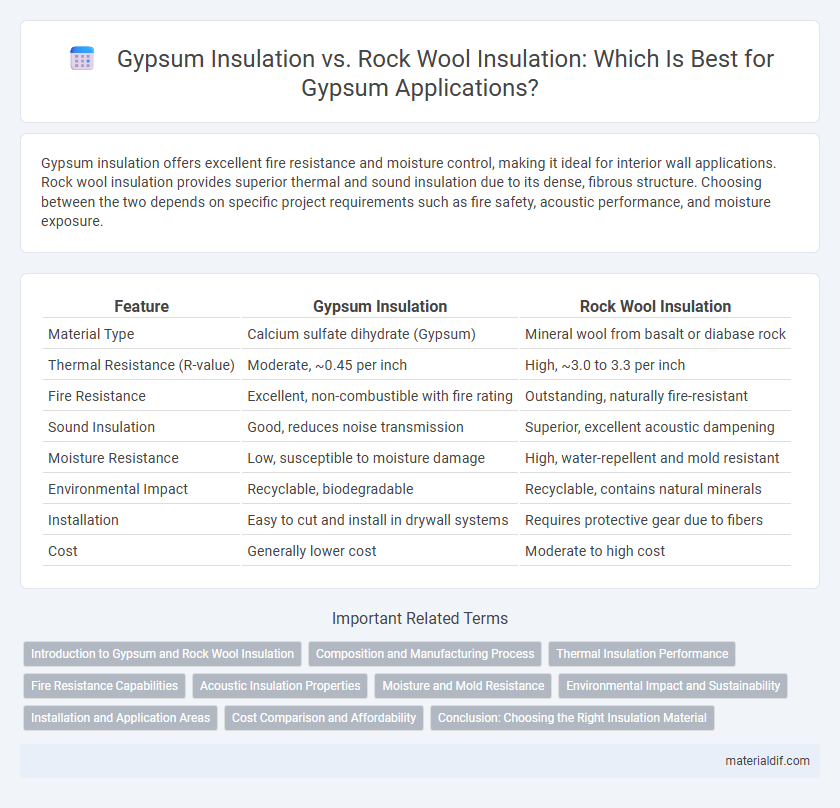Gypsum insulation offers excellent fire resistance and moisture control, making it ideal for interior wall applications. Rock wool insulation provides superior thermal and sound insulation due to its dense, fibrous structure. Choosing between the two depends on specific project requirements such as fire safety, acoustic performance, and moisture exposure.
Table of Comparison
| Feature | Gypsum Insulation | Rock Wool Insulation |
|---|---|---|
| Material Type | Calcium sulfate dihydrate (Gypsum) | Mineral wool from basalt or diabase rock |
| Thermal Resistance (R-value) | Moderate, ~0.45 per inch | High, ~3.0 to 3.3 per inch |
| Fire Resistance | Excellent, non-combustible with fire rating | Outstanding, naturally fire-resistant |
| Sound Insulation | Good, reduces noise transmission | Superior, excellent acoustic dampening |
| Moisture Resistance | Low, susceptible to moisture damage | High, water-repellent and mold resistant |
| Environmental Impact | Recyclable, biodegradable | Recyclable, contains natural minerals |
| Installation | Easy to cut and install in drywall systems | Requires protective gear due to fibers |
| Cost | Generally lower cost | Moderate to high cost |
Introduction to Gypsum and Rock Wool Insulation
Gypsum insulation, made from calcium sulfate dihydrate, offers excellent fire resistance and moisture regulation properties, making it a popular choice in building construction. Rock wool insulation, derived from volcanic basalt rock and recycled slag, provides superior thermal performance and soundproofing capabilities, widely used for energy efficiency and acoustic control. Both materials contribute to sustainable building practices by enhancing indoor air quality and reducing energy consumption.
Composition and Manufacturing Process
Gypsum insulation consists primarily of calcium sulfate dihydrate, produced by heating gypsum rock to remove water content, forming a lightweight, fire-resistant material. Rock wool insulation is made from natural basalt or diabase rocks melted at high temperatures and spun into fibrous mats, providing superior thermal and acoustic properties. The manufacturing of gypsum insulation involves calcination, while rock wool requires melting and fiberizing, resulting in distinct structural characteristics influencing their insulation performance.
Thermal Insulation Performance
Gypsum insulation offers moderate thermal resistance with an R-value typically ranging from 0.45 to 0.7 per inch, providing effective heat retention and energy efficiency in residential and commercial buildings. Rock wool insulation surpasses gypsum in thermal performance, boasting an R-value between 3.0 and 4.2 per inch, which significantly reduces heat transfer and enhances thermal comfort. Its dense fiber structure also provides superior fire resistance and soundproofing, making rock wool a preferred choice for robust thermal insulation solutions.
Fire Resistance Capabilities
Gypsum insulation offers excellent fire resistance due to its high water content and ability to retard flames, typically with a fire rating of up to 1 hour or more in wall assemblies. Rock wool insulation, composed of non-combustible mineral fibers, provides superior fire resistance with fire ratings often exceeding 2 hours, and it does not contribute to flame spread or produce toxic smoke. Both materials enhance building safety, but rock wool insulation is preferred for applications demanding higher fire endurance and minimum smoke production.
Acoustic Insulation Properties
Gypsum insulation offers moderate acoustic insulation by effectively reducing airborne noise due to its dense and solid structure, making it suitable for standard soundproofing needs. Rock wool insulation provides superior acoustic insulation with enhanced sound absorption and vibration dampening capabilities, thanks to its fibrous texture and porous composition. For environments requiring high-performance noise control, rock wool insulation outperforms gypsum in managing sound transmission and improving overall acoustic comfort.
Moisture and Mold Resistance
Gypsum insulation offers moderate moisture resistance due to its lime content, which helps inhibit mold growth when properly sealed and maintained. Rock wool insulation excels in moisture and mold resistance because it is water-repellent and naturally non-absorbent, preventing mold development even in damp conditions. Both materials contribute to moisture control, but rock wool provides superior protection in high-humidity environments.
Environmental Impact and Sustainability
Gypsum insulation offers significant environmental benefits due to its recyclability and natural abundance, reducing landfill waste and lowering carbon emissions during production. Rock wool insulation, derived from volcanic rock and recycled slag, provides high thermal efficiency but has a higher embodied energy compared to gypsum. Both materials contribute to sustainable building practices, yet gypsum's lower environmental footprint makes it a preferable choice for eco-friendly insulation solutions.
Installation and Application Areas
Gypsum insulation is lightweight and easy to install, making it ideal for residential walls and ceilings where fire resistance and soundproofing are needed. Rock wool insulation offers superior thermal and acoustic performance, excelling in industrial applications and areas exposed to moisture due to its water-resistant properties. Both materials are commonly used in commercial buildings, but gypsum is preferred for quick installation, while rock wool is favored for durability and enhanced fire protection.
Cost Comparison and Affordability
Gypsum insulation generally costs less than rock wool insulation, making it a more affordable option for budget-conscious projects. Rock wool insulation offers superior thermal and soundproofing properties but tends to have higher material and installation expenses. Evaluating long-term energy savings against initial costs is crucial when choosing between these two insulation materials.
Conclusion: Choosing the Right Insulation Material
Gypsum insulation offers superior fire resistance and moisture control, making it ideal for environments prone to dampness and fire hazards. Rock wool insulation excels in thermal performance and soundproofing, providing excellent energy efficiency and acoustic benefits. Selecting the right insulation depends on the specific needs of fire safety, moisture resistance, and thermal or acoustic priorities within the building project.
Gypsum insulation vs Rock wool insulation Infographic

 materialdif.com
materialdif.com